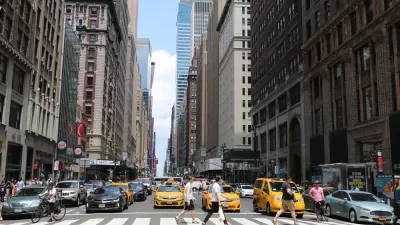Exotic street performers in the plaza have caused Mayor Bill de Blasio to reconsider his initial opposition to street plazas. Unlike his police commissioner and the governor, de Blasio has yet to make a decision on the removal of Times Square plaza.
Following through with a statements he made as a mayoral candidate in 2013 that he would consider opening Times Square and Herald Square to auto traffic, "Mayor Bill de Blasio said on Thursday that he would consider removing the pedestrian plazas from Times Square in a bid to restore order in the crowded streets of the Manhattan crossroads," writes Michael M. Grynbaum for The New York Times.
The move, which the mayor described as one of several options to be considered by a task force of New York City officials, would undo a signature accomplishment of Mr. de Blasio’s predecessor, Mayor Michael R. Bloomberg, whose decision to close part of Times Square to vehicular traffic has been hailed as an influential innovation in urban design.
"Mayor Bill de Blasio said on Tuesday (Aug 18) that he sees the women (called Desnudas - video) parading around Times Square covered in little but body paint not as creative artists, but as pushy panhandlers whose efforts to separate tourists from their money should be regulated," writes Patrick McGeehan.
De Blasio "announced a task force to consider ideas on how to better prevent activities that the city deems illegal or harmful to the area’s quality of life," writes Grynbaum. His police commissioner, William J. Bratton, who will co-chair the task force, was ready "to just dig the whole damn thing up and put it back the way it was,” he said in a radio interview.
Gov. Andrew M. Cuomo, who has often been at odds with the mayor, has already come out for the removal of the plazas.
Grynbaum goes on to write about the reaction to their possible removal in social media.
FULL STORY: Mayor de Blasio Raises Prospect of Removing Times Square Pedestrian Plazas

Planetizen Federal Action Tracker
A weekly monitor of how Trump’s orders and actions are impacting planners and planning in America.

Maui's Vacation Rental Debate Turns Ugly
Verbal attacks, misinformation campaigns and fistfights plague a high-stakes debate to convert thousands of vacation rentals into long-term housing.

San Francisco Suspends Traffic Calming Amidst Record Deaths
Citing “a challenging fiscal landscape,” the city will cease the program on the heels of 42 traffic deaths, including 24 pedestrians.

Amtrak Rolls Out New Orleans to Alabama “Mardi Gras” Train
The new service will operate morning and evening departures between Mobile and New Orleans.

The Subversive Car-Free Guide to Trump's Great American Road Trip
Car-free ways to access Chicagoland’s best tourist attractions.

San Antonio and Austin are Fusing Into one Massive Megaregion
The region spanning the two central Texas cities is growing fast, posing challenges for local infrastructure and water supplies.
Urban Design for Planners 1: Software Tools
This six-course series explores essential urban design concepts using open source software and equips planners with the tools they need to participate fully in the urban design process.
Planning for Universal Design
Learn the tools for implementing Universal Design in planning regulations.
Heyer Gruel & Associates PA
JM Goldson LLC
Custer County Colorado
City of Camden Redevelopment Agency
City of Astoria
Transportation Research & Education Center (TREC) at Portland State University
Jefferson Parish Government
Camden Redevelopment Agency
City of Claremont



























